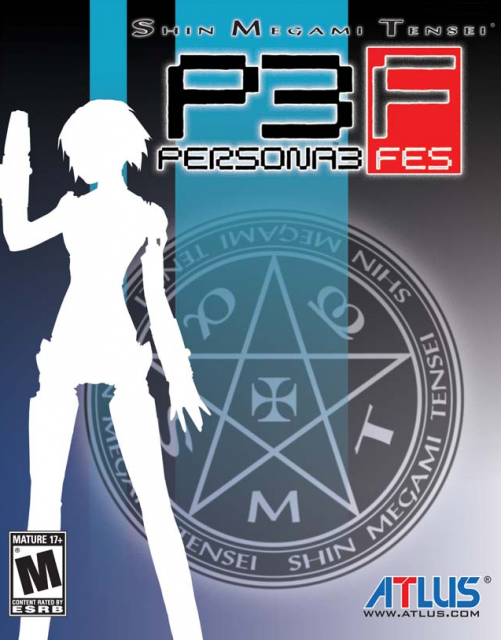A thoughtfully crafted narrative about tragedy and perseverance.
It was during the mid 1990s that most video game franchises made the leap to the third dimension. Persona, though, is not most franchises; it took the series six years to fully enter the third dimension in the form of Shin Megami Tensei: Persona 3.However, such a long wait was entirely worth it. Boasting both an intricately thought out story, memorable characters, and a very strong battle system, Persona 3 is a worthy entry in the PS2’s storied history of role-playing games. The additions brought to this core game in the re-release, Persona 3 FES, only sweeten the deal.
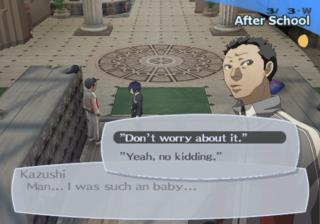
The commonality maintained between these two games, though, is that much of their appeal is from a narrative approach. The game begins with a Japanese youth transferring to a new high school on Tatsumi Port Island: Gekkoukan High. Soon, he not only finds himself swept up into a major conflict, but awakens to the powers of Persona (a magical other self) and the Dark Hour (a time of day only a select few can experience). While these details are important toward understanding Persona 3, the game’s strength is not in its minutiae; if anything, the occasional slip-up in this area makes it one of its few weaknesses. No, the game’s strengths lie in the greater picture. It interprets every new event as an opportunity to relay to you its core messages, such as “time’s march forward is inevitable”, “with great power comes greater responsibility”, “personal growth comes from tragedy”, etc. While the game isn’t subtle about them, these messages never feel overt or at odds with what is being presented. Instead, it lets the plot and themes work in tandem, the characters’ problems enhancing the overall message. The various plot twists the story throws at you can easily verify this. While it is incredibly difficult to call them predictable, they fit perfectly within the world that Persona 3 constructs for itself and propel the story in some interesting new directions.
This applies especially well to the characters who are most affected by such surprising events. In fact, a lot of the game’s appeal lies in the characters, whose difficulties are likely to strongly resonate with you emotionally. At first, this may not seem true. Half of the characters, like Yukari Takeba and Junpei Iori, seem average at best and unlikable at their worst. The other half come across as dangerous psychopaths who are willing to do anything to get their way, an observation the game makes about these characters, as well. With time, though, this fixes itself, and not just because the number of characters involved increases exponentially. The reasons for this have more to do with quality writing and characterization. Many of the characters have some quirky personality trait that makes them seem more approachable and human, whether it’s the magniloquent Elizabeth or the strangely religious Gourmet King. These traits soon give way to some very developed character arcs. Even Junpei and Mitsuru eventually blossom into more complex characters worthy of some level of emotional commitment. Indeed, only one character in the game can be considered weak or flat. Given how many characters are in the game, though, this should be considered a great accomplishment in its favor.
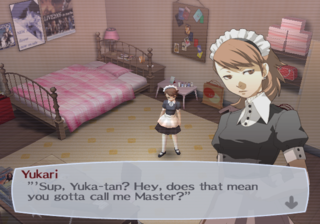
Atlus must have been aware of this strength while developing the game, as there is an entire feature dedicated just to it: the Social Link. Beyond the characters themselves, the appeal for Social Links is largely in the strategy that goes into it. Characters are only available to talk to on certain days; different Links will affect each other in different ways (especially so with the opposite gender); and the story will sometimes flat out refuse to let you Social Link because of some major event, like a test or summer break. Fortunately, the game will most often alert you as to when these events are going to happen, allowing you to plan things out and think it all through. (This has the added benefit of playing into the game’s themes about looking toward the future at all times.) At least outside the Links themselves; within the Links, there is very little room for tactics. When presented with a choice, the right answer is usually the most obvious one: be polite and agree with whatever the other person is saying, personal growth be damned.
This pattern continues into battles, as well. A lot of the fun in the battles comes from their speed and the general simplicity of the systems involved. You can only battle on the game’s (admittedly quite lenient) terms, and most sessions last well under an hour, making these fights a perfect, low investment means of occupying small bouts of time. But this appeal comes at the expense of any deep strategy. Victory in battle is dependent on exploiting the enemies’ magical weaknesses, and with the ability to change his spell line-up at will, the main character is the only character with full range to do this. In time, every battle is reduced to the main character simply blasting the opposition with whatever spell happens to work best for that situation. Because you’ll be fighting the same enemies for extended periods in the game, memory will only make the job easier. True, this behavior is self destructive, as it wastes the SP necessary to execute it very fast, but that SP can be restored easily by returning to the first floor of Tartarus, thus eliminating a potential source of risk in this otherwise lucrative stratagem.
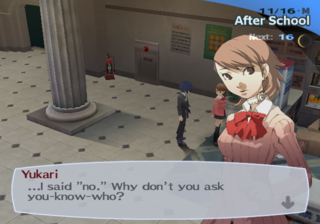
There are hints of strategy, though. For instance, the All Out Attack, in which everybody bum-rushes the enemy when they are all down, sounds like it may speed up battles significantly. However, the catch is that enemies who survive the attack get the turn they would have missed if they stayed knocked down. This is especially relevant during boss battles, which are perhaps the pinnacle of the game’s battle system. Because of how much stronger they are than you, the bosses demand heat-of-the-moment prioritization of both your own behavior and that of your allies, turning their victory over them into something of an accomplishment. But to say that this is the only source of enjoyment bosses provide would be an incomplete statement, as their design is also top notch. What is there not to like about fighting a roulette wheel that can harm friend or foe, or a horse and tank cooperating in order to destroy your team? The final boss alone is perhaps one of the better bosses to be found in video games. Yet it is important to note that these are largely exceptions in a system whose battles lack complexity.
In theory, your partners should balance this out and add a tactical layer to fights. After all, they are completely out of your control. The best you can do is give them suggestions such as “full assault” or “conserve SP”. Yet this is rarely necessary, as your allies can usually handle themselves just fine in battle. Although not always perfect, they are competent enough to learn what attacks will and will not work on the enemies before them. While this attention to detail in the AI is well appreciated, it essentially neuters an aspect of the game that might otherwise be completely necessary. This is on top of the fact that party commands are not saved between battles (or even different floors of Tartarus), necessitating that they be re-entered with each fight. Overall, the battles in Persona 3 encourage simplicity over strategy.
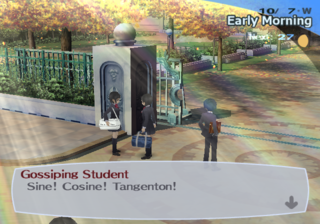
If the battle system is weak in direct strategy, though, then it simply shines in its use of meta strategy. It is important not only to keep a balanced team and know everybody’s roles, but also your own. As smart as your allies are, the enemies can be just as smart, immediately capitalizing on any weaknesses they spot. To get anywhere in the game, it is necessary to plan every last detail ahead before doing anything. Most of this is done by fusing new Personae in the Velvet Room, a system that is, admittedly, obtuse. The levels and Arcana of any given Personae affect the end result, but not in a way that is immediately obvious. Some options are just not allowed for completely unexplained reasons. However, this is ultimately a non-issue. Understanding how these systems function is not necessary, as you are often presented with enough options to meet your needs for any given situation. Perhaps it is because of how many options you have for a Persona at any given time that it’s still hard to find the right one for what you are currently facing. This, when combined with the difficult highs the game can reach, create an easy to feel sense of accomplishment upon passing the game’s various milestones.
Of course, even without Social Links or Tartarus, the world of Tatsumi Port Island still holds a lot to those willing to seek it out. For instance, crazy Velvet Room girl Elizabeth almost always has quests to offer you. Ranging from hunting down certain enemies to bringing soda to a thirsty girl, these quests generally exist to expose you to all the systems and facets of the world that the game has to offer. Their quality tends to vary. Anything dealing with the regular world is entertaining largely because of the mild humor, whereas most of the Tartarus themed quests are a pain to deal with simply because they are too reliant on chance for success. These quests are completely optional, though, meaning that the worse ones can often be ignored without suffering any major losses.Outside quests, there is school to deal with, which does a good job of creating some type of academic atmosphere. While not necessary, each class will teach you something new, ranging from Japanese history to the occult. Consider it a minor bonus.
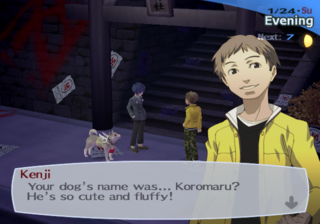
There is also The Answer, a 30 hour epilogue to Persona 3 (referred to as “The Journey” here) added specifically for FES. At least compared to the main campaign, a considerable amount of the fights in The Answer are absolutely brutal. Part of this is because any progress made in Persona 3 proper does not carry over here (a fact that the game goes to great lengths to justify), but far more of it is simply due to design. Not only is it necessary to exploit weaknesses in battle to win, but also to keep track of both yourself and your partners at all times. In short, The Answer demands control and full awareness. It is precisely because of this that the fights in this mode are so rewarding. They force you to pay attention to every last detail, knowing what Personae you should fuse and bring into battle. Finally coming out on top in the end is one of the more satisfying experiences to be found in the game.
The story that The Answer tells might as well be the cherry on top; a fitting epilogue to the events of Persona 3. Without spoiling the ending to the main story, The Answer deals largely with how the cast deals with loss and tragedy. They find themselves stuck in a time loop and must ultimately confront their issues in order to escape it. Naturally, this is a great opportunity to look into the personalities and back-stories of the various characters, an opportunity that does not go to waste. It is incredibly easy to feel emotionally invested in characters like Ken, Yukari, Aigis, etc. Much like The Journey, The Answer is highly focused, tight, and very well executed. Mostly. Of course, not every detail is perfect. The ending, for example, is too neat, failing to ensure that its conclusions are completely plausible. This is in addition to the story continuing for longer than it should because of forced conflict among the characters.

In fact, Persona 3 as a whole definitely has flaws that are worth mentioning, as it is by no means a perfect game. For example, the pacing feels slow and incredibly strange. Very rarely will you feel like you are experiencing a major moment, because everything always feels like it is in preparation for something else, partially because of how the plot is structured. New characters and sub-plots will often introduce themselves to you, only to recede as quickly as they were introduced and return far later in the story. Needless to say, it can be disorienting. A problem like this is only compounded by how slowly the plot reveals itself. Often times, it will take a few weeks or so for major events to occur. Given how quickly days pass in this game, though, it may not be of that much concern, especially since the Social Links exist at least partially to keep you sated while the main plot lies dormant. However, given the game’s length of at least 100 hours, it is still something to keep in mind.
In addition, the presentation is noticeably lacking. Not in terms of the in-game graphics. With clearly defined, expressive models and an overall very pleasing art design, it is hard to find issue with them. Instead, much of the fault lies in the animated cutscenes scattered throughout the narrative. What should be an occasional reward for investing so much time into game, or a means of granting the story more flexibility than it would have otherwise, falls flat on its face. A lot of the drawings look very cheap, faces being rendered with only a few simple lines and shapes and speech being rendered as a flickering of the mouth. This can get so bad that characters can be seen without their defining features (LINK AIGIS’S HEADBAND MISSING IN ENDING). True, some of the faces are wrought with intricate detail and show a lot of work put into them, but they are the exception rather than the rule. (Fortunately, Persona 3’s music does not fall victim to the same problems its graphics do. Many of the songs have a modern, almost sexual feel to them, and while not every piece is a success, the soundtrack as a whole is definitely very strong.)
In terms of the entire product, though, these faults do nothing to bring down the many things Persona 3 FES does right. The story, for instance, has a very definite purpose and fantastically executes on it, demonstrating clarity in its themes and some memorable, well written characters. Complementing these aspects are a set of gameplay mechanics dedicated to revealing more about the characters and a battle system that has a lot of depth, if not strategy. Together, they form one of the more intelligent, thoughtfully designed RPGs in the PlayStation library.
